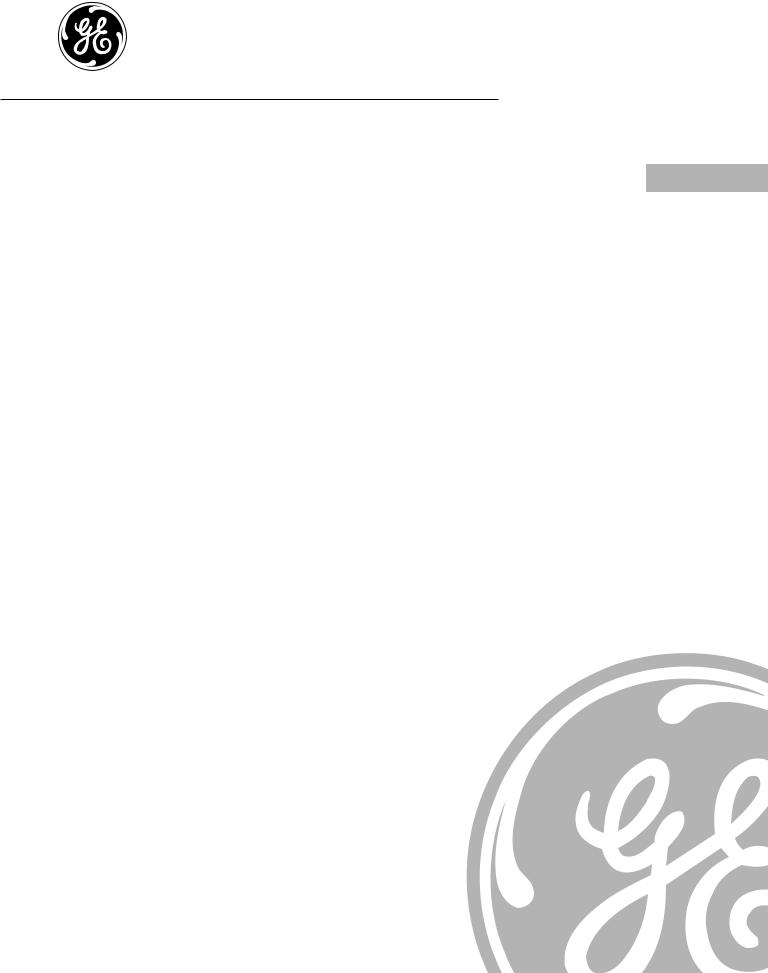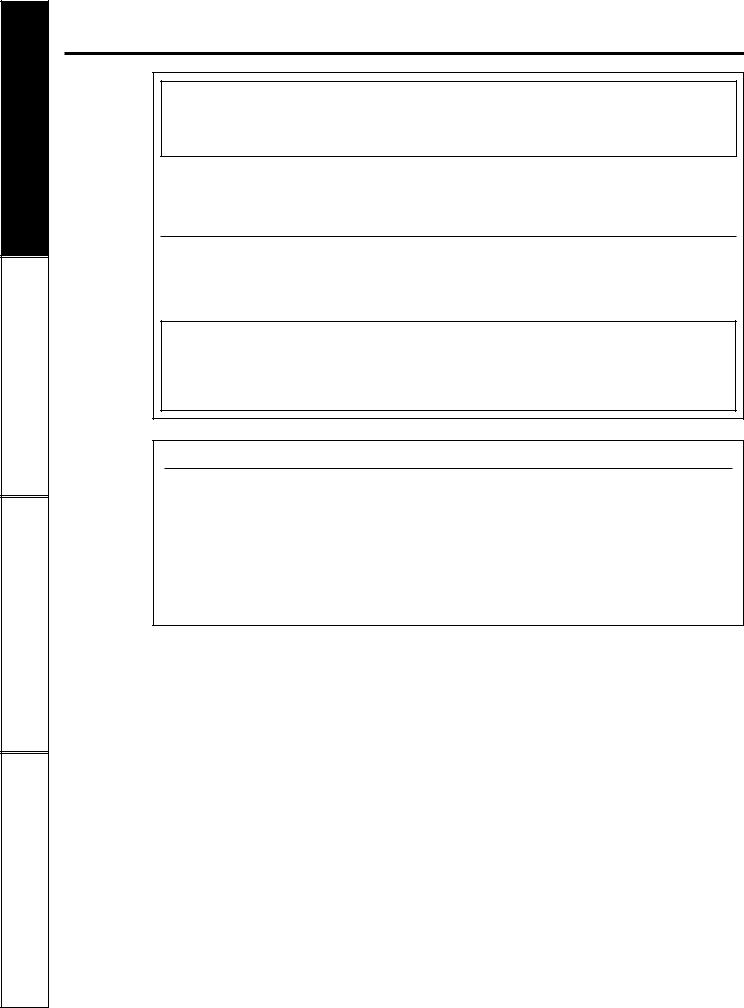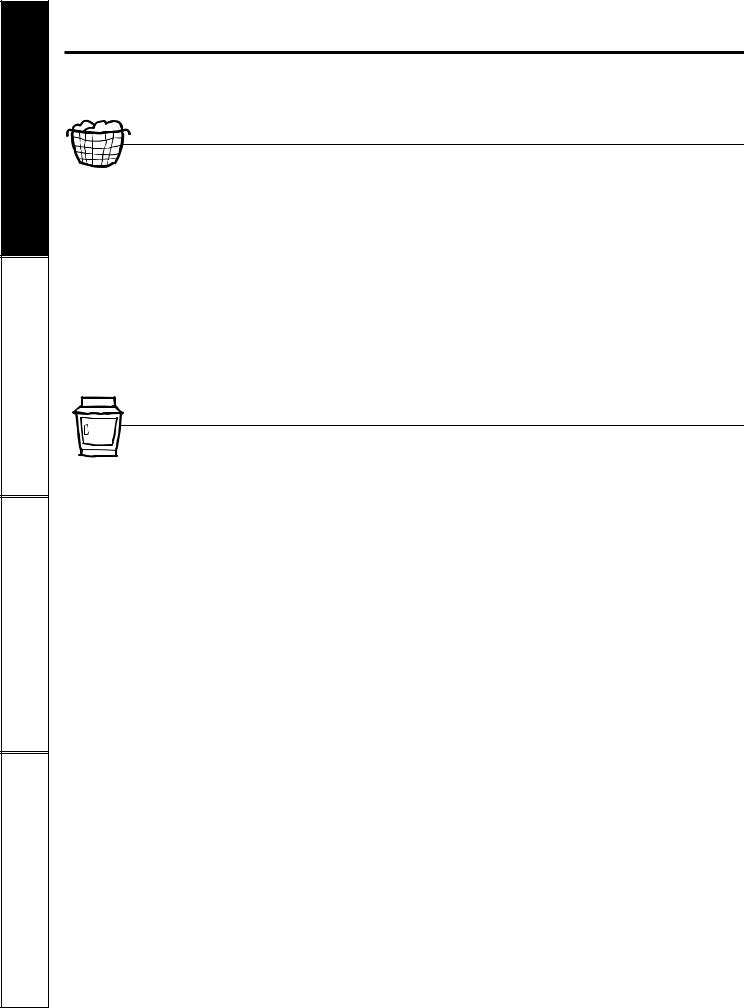GE DCCD330 User Manual

Dryers
Commercial
ge.com
Safety Information . . . . . . . . 2–5
Operating Instructions
Countdown Display . . . . . . . . . . . . . .7
Reversing the Door . . . . . . . . . . . . . .6
Venting . . . . . . . . . . . . . . . . . . . . . . . . .8
Care and Cleaning . . . . . . . . . . 9
Consumer Support
Consumer Support . . . . .Back Cover
General Principles
of Good Practice . . . . . . . . . . . . . . .11
Warranty . . . . . . . . . . . . . . . . . . . . . 10
Write the model and serial numbers here:
Model # ______________
Serial #________________
They are on the label on the front of the dryer behind the door.
Owner’s Manual
DCCB330
DCCD330
175D1807P538 49-90270 12-05 JR

Safety Instructions
Operating Instructions
Care and Cleaning
Consumer Support
IMPORTANT SAFETY INFORMATION.
READ ALL INSTRUCTIONS BEFORE USING.
 WARNING!
WARNING!
For your safety, the information in this manual must be followed to minimize the risk of fire or explosion, electric shock, or to prevent property damage, personal injury, or death.
Installation and service must be performed by a qualified installer, service agency or the gas supplier.
FOR GAS DRYERS: YOU MUST POST IN A PROMINENT LOCATION
1.Instructions to follow if the user smells gas: Contact your local gas supplier for information to be displayed.
2.Instructions concerning flammable materials as follows:
FOR YOUR SAFETY:
Do not store or use gasoline or other flammable vapors and liquids in the vicinity of this or any other appliance.
California Safe Drinking Water and Toxic Enforcement Act
This act requires the governor of California to publish a list of substances known to the state to cause cancer, birth defects or other reproductive harm and requires businesses to warn customers of potential exposure to such substances.
Gas appliances can cause minor exposure to four of these substances, namely benzene, carbon monoxide, formaldehyde and soot, caused primarily by the incomplete combustion of natural gas or LP fuels.
Properly adjusted dryers will minimize incomplete combustion. Exposure to these substances can be minimized further by properly venting the dryer to the outdoors.
2

ge.com
PROPER INSTALLATION
This dryer must be properly installed and located in accordance with the Installation Instructions before it is used. If you did not receive an Installation Instructions sheet, you can receive one by visiting ge.com, or by calling 800.GE.CARES (800.432.2737).
■Properly ground dryer to conform with all governing codes and ordinances. Follow details in the Installation Instructions section.
■Install or store where it will not be exposed to temperatures below freezing or exposed to the weather.
■Connect to a properly rated, protected and sized power supply circuit to avoid electrical overload.
■Remove all sharp packing items and dispose of all shipping materials properly.
■In fulfilling the specific needs of different commercial installations the purchaser of this dryer may wish to locate the coin box and controls in any of a number of locations.
The responsibility for the proper performance of this work lies solely with the purchaser.
It should be done by properly trained and qualified personnel, and in accordance with local code requirements.
■Any coin box or similar device added to the dryer, either electrically or mechanically, should be properly grounded.
■Remove any accumulated time by manually rotating timing cam in the coin box counterclockwise until switch shuts off. Apply a slight additional counterclockwise pressure to
further seat drive. Make certain not to turn cam past switch shutoff position. Otherwise, one increment of time will be gained. Switches are off when the plastic switch actuating arm (inner) is down and all 3 switch buttons are depressed.
Exhaust/Ducting
1 This dryer MUST be exhausted to the outside.
2 Use only rigid metal 4″ diameter ductwork inside the dryer cabinet. Use only rigid metal or flexible metal 4″ diameter ductwork for exhausting to the outside. USE OF PLASTIC OR
OTHER COMBUSTIBLE DUCTWORK CAN CAUSE A FIRE. PUNCTURED DUCTWORK CAN CAUSE A FIRE IF IT COLLAPSES OR BECOMES OTHERWISE RESTRICTED IN USE OR DURING INSTALLATION.
Follow details in the Installation Instructions section.
3
Instructions Safety
Instructions Operating
Cleaning and Care
Support Consumer

Safety Instructions
Operating Instructions
Care and Cleaning
Consumer Support
IMPORTANT SAFETY INFORMATION. READ ALL INSTRUCTIONS BEFORE USING.
 WARNING!
WARNING!
YOUR LAUNDRY AREA
■Keep the area underneath and around your appliances free of combustible materials, such as lint, paper, rags, chemicals, gasoline and other flammable vapors and liquids.
■Keep the floor around your appliances clean and dry to reduce the possibility of slipping.
■Keep area around the exhaust opening and surrounding areas free from the accumulation of lint, dust and dirt.
■Do not obstruct the flow of ventilating air. Do not stack or place laundry or throw rugs against the front or back of the dryer.
■Close supervision is necessary if this appliance is used by or near children. Do not allow children to play on, with, or inside this or
any other appliance.
■Keep all laundry aids (such as detergents, bleaches, etc.) out of the reach of children, preferably in a locked cabinet. Observe all warnings on container labels to avoid injury.
■Never climb on or stand on the dryer top.
■Do not install or store this appliance where it will be exposed to the weather.
WHEN USING YOUR DRYER
■Never reach into the dryer while the drum is moving. Before loading, unloading or adding clothes, wait until the drum has completely stopped.
■Clean the lint filter before each load to prevent lint accumulation inside the dryer or in the room.
DO NOT OPERATE THE DRYER WITHOUT THE LINT FILTER IN PLACE.
■Do not wash or dry articles that have been cleaned in, washed in, soaked in or spotted with combustible or explosive substances (such as wax, oil, paint, gasoline, degreasers, dry-cleaning solvents, kerosene, etc.) which may ignite or explode. Do not add these substances to the wash water. Do not use or place these substances around your washer or dryer during operation.
■Any article on which you have used a cleaning solvent or that contains flammable materials (such as cleaning cloths, mops, towels used in beauty salons, restaurants, or barber shops, etc.) must not be placed in or near the dryer until solvents or flammable materials have been removed. There are many highly flammable items used in homes such as acetone, denatured alcohol, gasoline, kerosene, some household cleaners, some spot removers, turpentines, waxes, wax removers and products containing petroleum distillates.
■The laundry process can reduce the flame retardancy of fabrics. To avoid such a result, carefully follow the garment manufacturer’s care instructions.
■Do not dry articles containing rubber, plastic or similar materials such as padded bras, tennis
shoes, galoshes, bath mats, rugs, bibs, baby pants, plastic bags, pillows, etc. that may melt or burn. Some rubber materials, when heated, can under certain circumstances produce fire by spontaneous combustion.
■Do not store plastic, paper or clothing that may burn or melt on top of the dryer during operation.
■Garments labeled Dry Away from Heat or Do Not Tumble Dry (such as life jackets containing Kapok) must not be put in your dryer.
■Do not dry fiberglass articles in your dryer. Skin irritation could result from the remaining particles that may be picked up by clothing during subsequent dryer uses.
■To minimize the possibility of electric shock, unplug this appliance from the power supply or disconnect the dryer at the distribution panel by removing the fuse or switching off the circuit breaker before attempting any maintenance or cleaning (except the removal and cleaning of
the lint filter). NOTE: Turning the Cycle Selector knob to an off position does NOT disconnect the appliance from the power supply.
■Do not spray any type of aerosol into, on or near dryer at any time.
■Do not place items exposed to cooking oils in your dryer. Items contaminated with cooking oils may contribute to a chemical reaction that could cause a load to catch fire.
4
